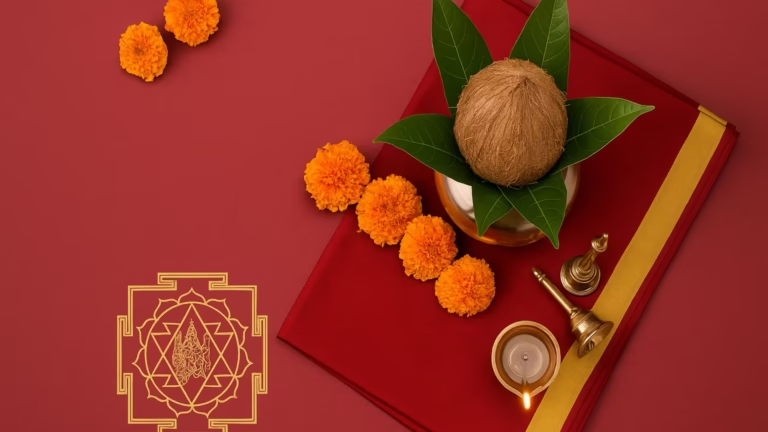Navratri is the great festival of Shakti, observed over nine days to worship the nine forms of Goddess Durga—collectively called the Navadurga. Toward the concluding phase of the festival, the tradition of Kumari/Kanjak Pujan holds special significance. In this rite, nine girls (symbolic of the nine goddesses) and one boy (symbolic of Bhairava, the guardian of Shakti’s domain) are respectfully invited, honored, and fed, followed by gifts and dakshina (offering). This article explains, in a structured and practical way, the reasons, method, rules, precautions, and scriptural/traditional rationale of Kanjak Pujan for Navratri 2025.
Table of Contents
What Is Kumari/Kanjak Pujan?
Kumari or Kanjak Pujan is the worship of unmarried girls (typically between 2 and 10–12 years of age) as living embodiments of the Goddess. Traditionally, nine girls are honored, representing the nine forms of Durga—from Shailaputri to Siddhidatri. In many regions, a young boy is also seated along with them, symbolizing Bhairava (often called langoor in folk usage), the protector of the Goddess’s circle.
Traditional Aims
- Direct reverence for the divine feminine: In both scripture and practice, young girls are regarded as the manifestation of Shakti (divine power).
- Remembrance of the Navadurga: Honoring nine girls keeps the nine forms of the Goddess at the center of devotion and invites their grace.
- Gratitude through charity: As a concluding act of Navratri vows, anna-daan (feeding), vastra-daan (offering clothes), and other gifts cultivate gratitude and service.
- Social and cultural reinforcement: The practice publicly affirms respect, safety, and dignity for girls in society.
read also: Navratri: The 9 Forms of Navdurga and Their Spiritual Significance
Scriptural and Traditional Basis (A Brief Overview)
The idea of Kumari worship is deeply rooted in the Shakti tradition and is nourished by the broader stream of worship seen across texts such as the Devi Mahatmya (Durga Saptashati from the Markandeya Purana), Devi Bhagavata, Kalika Purana, Skanda Purana, and more. The specifics vary by region and lineage, but the core sentiment remains constant: to reverentially worship the divine principle present in girls.
Note: Chapter/verse references and liturgical nuances can differ across languages and textual recensions. It is prudent to follow your local panchang (almanac) and consult a trusted acharya/priest for the exact observance according to your tradition.
Why This Guide Matters in 2025
For Navratri 2025, communities will again observe Kanjak Pujan on Ashtami and/or Navami depending on local calendars. Since tithi timings can vary slightly across regions, always confirm Ashtami/Navami dates and auspicious windows with a reliable panchang. This guide equips you with the complete procedure, essential materials, rules/precautions, and the spiritual-social meaning so you can prepare with confidence.
When Is Kanjak Pujan Performed? (Ashtami or Navami)
- In many traditions, Kumari Pujan is performed on Durga Ashtami.
- In several places, it is observed on Maha Navami—or even on both days.
- If circumstances prevent it on Ashtami/Navami, some families perform a shortened rite on the last day of Navratri or just before Vijayadashami. Always heed your local tradition/acharya.
Symbolism: Why Nine Girls and One Boy?
Nine Girls = Symbols of the Navadurga
- Shailaputri – Resolve, grounded beginnings
- Brahmacharini – Austerity, discipline, pursuit of knowledge
- Chandraghanta – Courage, protection, removal of obstacles
- Kushmanda – Cosmic creation, vitality, prosperity
- Skandamata – Nurturing motherhood, compassion
- Katyayani – Justice, valor, destruction of evil
- Kalaratri – Dispeller of fear, end of negativity
- Mahagauri – Purity, serenity, auspiciousness
- Siddhidatri – Fulfillment, attainment, completion
The One Boy (Bhairava/Langoor)
Bhairava is revered as the guardian of the Shakti mandala. Seating one boy alongside the girls honors this protective principle, symbolizing security, steadiness, and balance.
Materials You’ll Need (Checklist)
- Clean worship area, low seat/table (chowki) and kalash (pot) or a simple Durga altar
- Roli/kumkum, turmeric, akshata (uncooked rice), mauli (sacred thread)
- Flowers/garlands; (bel leaves/durva as per local custom)
- Oil or ghee lamp, incense
- Aarti plate, bell
- Bhog/prasada: traditionally poori, kala chana, and suji/atta halwa; in some regions, kheer/khichdi/sweets are common
- Dakshina, fruits, dry fruits, practical gifts (bangles/hair clips/handkerchiefs/stationery/books/clothes), small dupatta/chunri (optional)
- A water pot, bowl for washing feet, towel/napkin
Step-by-Step Method of Kanjak Pujan
1) Preparation and Sankalpa (Intention)
- Bathe and wear clean clothes; decorate the worship place.
- Set up the kalash and/or the Durga altar.
- As a family or as the votary, take a sankalpa (vow/intention): “At the conclusion of Navratri worship, we shall honor the living form of the Goddess through Kumari Pujan.”
2) Respectful Welcome of the Kanjak and the Boy
- On arrival, greet the children with namaste and offer seats.
- As appropriate, perform charan-prakshalan (washing of feet) and offer water for achamana (sipping ritual).
- Apply tilak, tie mauli, and offer flowers.
3) The Core Worship
- Light the lamp and perform aarti of the Goddess; chant the Navadurga names.
- Offer flowers, akshata, and kumkum to the girls as forms of the Devi.
- Recite brief hymns/stutis (e.g., verses from Devi Mahatmya, Kavach, or your family’s customary prayer).
4) Serving the Sacred Meal
- Serve poori–kala chana–halwa first to the Kanjak and the boy, then to family/devotees.
- Maintain hygiene and a calm, respectful atmosphere while serving.
5) Dakshina/Gifts and Taking Blessings
- Offer dakshina and practical gifts (books, stationery, clothes, fruits, etc.).
- Seek their blessings and bid farewell politely.
Key Rules and Precautions
- Respect above all: Ensure the children’s comfort, safety, and dignity at every step.
- Cleanliness and sattva: Food should be sattvic, fresh, hygienic, and made with care.
- Age and number: Traditionally 2–10/12 years; the ideal count is 9 + 1, but 1, 3, 5 girls are also acceptable where availability is limited. Intention matters most.
- No coercion: Avoid any pressure or camera-induced discomfort.
- Mindful dakshina: Prefer useful gifts over showmanship.
- Honor local tradition: Mantras and methods vary; follow your regional practice and acharya.
Spiritual and Social Benefits
Spiritual Perspective
- Grace of the Goddess: Remembering the Navadurga strengthens one’s practice and inner resolve.
- Ego-softening and compassion: Seeing divinity in children cultivates humility, service, and love.
Social Perspective
- Dignity for girls: The rite publicly upholds respect, safety, and education for girls.
- Community bonding: Collective celebration enhances neighborhood harmony and goodwill.
Frequently Asked Questions (FAQs)
Q1. Should Kanjak Pujan be done on Ashtami or Navami?
Both are prevalent. Many households observe it on Durga Ashtami, others on Maha Navami, and some on both. Follow your local panchang and tradition.
Q2. What if nine girls are not available?
That does not invalidate the worship. Traditions accept 1, 3, or 5 girls as well. Sincerity and respect are paramount.
Q3. Why is one boy (Bhairava/Langoor) included?
To honor the Bhairava principle—guardian of the Goddess’s circle—signifying protection, steadiness, and balance.
Q4. Is the poori–chana–halwa menu mandatory?
It is a popular folk-traditional combination. Many regions serve kheer, khichdi, malpua, or fruit-based meals. The essential point is sattvic, clean food prepared with devotion.
Q5. Is it necessary to give gifts/dakshina to the children?
Yes, but avoid showiness. Offer useful items and modest dakshina with warmth and gratitude.
Q6. Are mantras/recitations compulsory?
Not compulsory, yet aarti, Devi stuti, and chanting the Navadurga names are recommended. Recite what you can pronounce correctly and offer with devotion.
Planning for Navratri 2025: A Practical Checklist
- Confirm Ashtami/Navami with a trusted local panchang.
- Invite Kanjak and the boy respectfully; ensure parental consent.
- Prepare the materials list (lamp, roli, mauli, flowers, aarti plate, prasada, etc.).
- Cook sattvic food on time; prioritize hygiene.
- Keep gifts/dakshina simple and useful; avoid plastic-heavy packaging.
- Ensure the worship area is clean, decorated, and safe for seating and hand/feet washing.
- Keep brief hymns/verses or bhajans ready in advance.
Eco‑Friendly and Inclusive Tips
- Avoid single-use plastics; use steel/ceramic plates and tumblers.
- Prepare balanced quantities of food; distribute any surplus respectfully.
- Keep the celebration inclusive and respectful across communities.
Key Takeaway
The essence of Kanjak/Kumari Pujan is to honor the divine feminine, nurture compassion and service, and affirm a society where girls are respected and cherished. In 2025, as you observe Navratri, give primacy to sincerity, simplicity, and cleanliness. Remember that nine girls and one boy are not mere numbers—they are symbols of Navadurga and Bhairava, guiding us toward courage, balance, purity, and fulfillment. That is the spiritual and social heart of Kanjak Pujan—and the true success of Navratri.
read also: Types of Credit Cards: Features, Who They’re For, Pros & Cons (2025)


